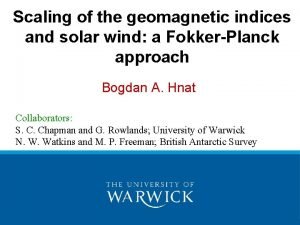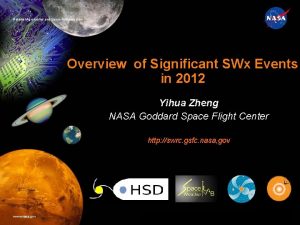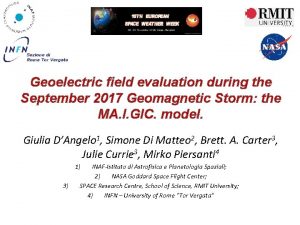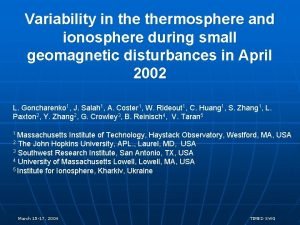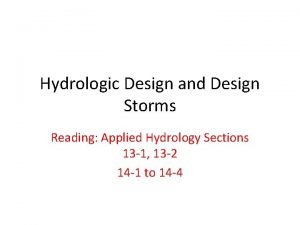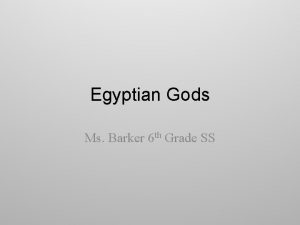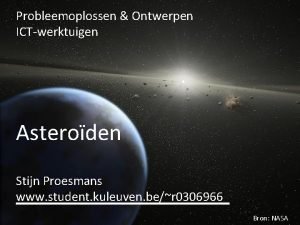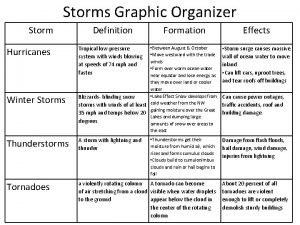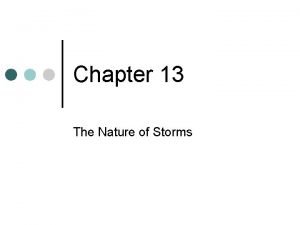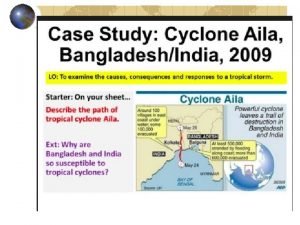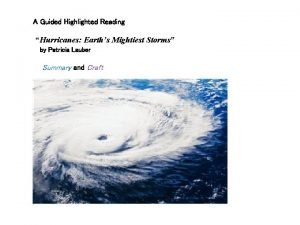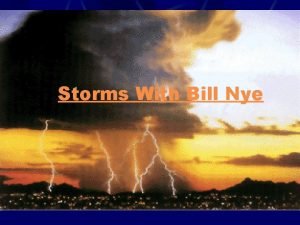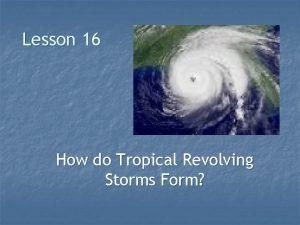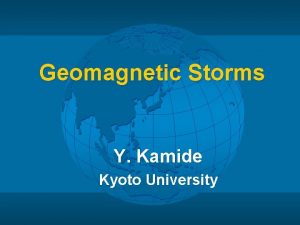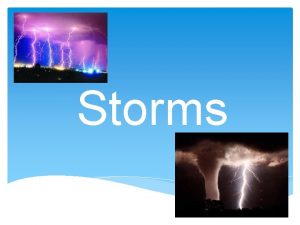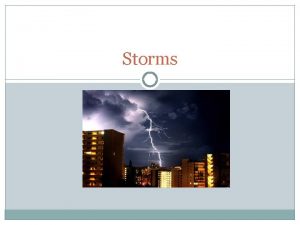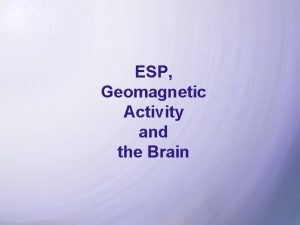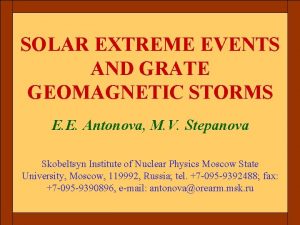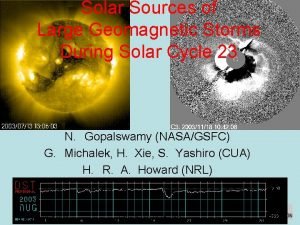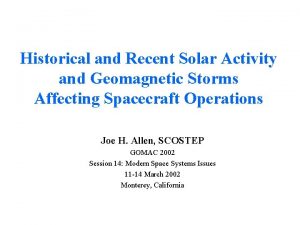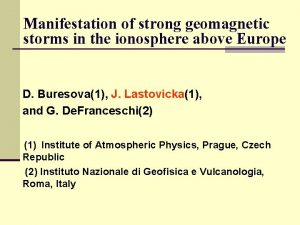What are Geomagnetic Storms Whitney Q Lohmeyer MIT

![Gonzalez et al. [1994] define geomagnetic storms as… “An interval of time when a Gonzalez et al. [1994] define geomagnetic storms as… “An interval of time when a](https://slidetodoc.com/presentation_image_h2/8a28116249ac07d183a5f52b1284935b/image-2.jpg)
![Gonzalez et al. [1994] define geomagnetic storms as… “An interval of time when a Gonzalez et al. [1994] define geomagnetic storms as… “An interval of time when a](https://slidetodoc.com/presentation_image_h2/8a28116249ac07d183a5f52b1284935b/image-3.jpg)

![Gonzalez et al. [1994] define geomagnetic storms as… “An interval of time when a Gonzalez et al. [1994] define geomagnetic storms as… “An interval of time when a](https://slidetodoc.com/presentation_image_h2/8a28116249ac07d183a5f52b1284935b/image-5.jpg)

![Gonzalez et al. [1994] define geomagnetic storms as… “An interval of time when a Gonzalez et al. [1994] define geomagnetic storms as… “An interval of time when a](https://slidetodoc.com/presentation_image_h2/8a28116249ac07d183a5f52b1284935b/image-7.jpg)






- Slides: 13

What are Geomagnetic Storms? Whitney Q. Lohmeyer MIT – Aero. Astro GEM 2013
![Gonzalez et al 1994 define geomagnetic storms as An interval of time when a Gonzalez et al. [1994] define geomagnetic storms as… “An interval of time when a](https://slidetodoc.com/presentation_image_h2/8a28116249ac07d183a5f52b1284935b/image-2.jpg)
Gonzalez et al. [1994] define geomagnetic storms as… “An interval of time when a sufficiently intense and long-lasting interplanetary convection electric field leads… to an intensified ring current strong enough to exceed some key threshold of the quantifying storm time Dst index”
![Gonzalez et al 1994 define geomagnetic storms as An interval of time when a Gonzalez et al. [1994] define geomagnetic storms as… “An interval of time when a](https://slidetodoc.com/presentation_image_h2/8a28116249ac07d183a5f52b1284935b/image-3.jpg)
Gonzalez et al. [1994] define geomagnetic storms as… “An interval of time when a sufficiently intense and long-lasting interplanetary convection electric field leads… to an intensified ring current strong enough to exceed some key threshold of the quantifying storm time Dst index”

Interplanetary Convection Electric Field Solar ejecta can cause traveling shock waves • Southward IMF at shock arrival magnetic reconnection – Solar wind and southward IMF cause electric field and drive magnetospheric convection Four primary mechanisms cause enhanced electric fields in interplanetary medium: • Primary phenomena: CMEs (solar max) and CIRs (declining) • HILDCAAs and Russell-Mc. Pherron effect
![Gonzalez et al 1994 define geomagnetic storms as An interval of time when a Gonzalez et al. [1994] define geomagnetic storms as… “An interval of time when a](https://slidetodoc.com/presentation_image_h2/8a28116249ac07d183a5f52b1284935b/image-5.jpg)
Gonzalez et al. [1994] define geomagnetic storms as… “An interval of time when a sufficiently intense and long-lasting interplanetary convection electric field leads… to an intensified ring current strong enough to exceed some key threshold of the quantifying storm time Dst index”

Intensified Ring Current • Ring current forms from drifts due to magnetic field gradient and curvature – Ions move from midnight to dusk – Electrons move from midnight towards dawn • Field decrease is linearly related to total energy of the ring current – Storm time ring current is largest consumer of energy in the magnetosphere Image Credit: Dmitriy Subbotin, 2010
![Gonzalez et al 1994 define geomagnetic storms as An interval of time when a Gonzalez et al. [1994] define geomagnetic storms as… “An interval of time when a](https://slidetodoc.com/presentation_image_h2/8a28116249ac07d183a5f52b1284935b/image-7.jpg)
Gonzalez et al. [1994] define geomagnetic storms as… “An interval of time when a sufficiently intense and long-lasting interplanetary convection electric field leads… to an intensified ring current strong enough to exceed some key threshold of the quantifying storm time Dst index”

Dst – Disturbance Storm Time Index • Dst: hourly average of global variation in horizontal component of earth’s magnetic field – Measured at four widely separated mid-latitude observatories – Range: approximately 100 to -600 n. T – Quiet/undisturbed conditions: 0 to -20 n. T Storm Classification Dst Threshold (n. T) Big <-200 Intense/Great -100 to -200 Moderate -50 to -100 Weak/Small -30 to -50

Kp: Another Geomagnetic Index • Kp: 3 -hour interval of observed fluctuation from ground-based magnetometers • Range: 0 -9 (9 is severe) • Kp has been more widely used than Dst – Available in final form in only a few weeks – Dst requires more analysis to produce, and has been delayed for up to years – Difficult to interpret physically b/c variations caused by many conditions (magnetopause currents, auroral electrojects, etc. )

Kamide et al. , 1998

Who cares about storms? • “The economic cost of a severe geomagnetic storm could reach US$1 -2 trillion during the first year alone with recovery times of 4 -10 years” – Space Studies Board of the U. S. National Academies, 2008 [NRC, 2008; Baker, 2009] • Satellite systems and continental-scale power generation/distribution systems – 1989 Hydro Quebec power system – Space systems: internal charging (Anik E 1/E 2) – Solar protons harm humans!

References Baker, D. N. , “What is Space Weather”, Adv. Space Research, Vol. 22(1) pp. 7 -16, 1998. Baker, D. N. (2000), The Occurrence of Operational Anomalies in Spacecraft and Their Relationship to Space Weather, IEEE Transactions on Plasma Science, 28(6), doi: 10. 1109/27. 902228. Baker, D. N. “How to Cope with Space Weather”. Science. 297, 1486 -1487. (2002); doi: 10. 1126/science. 1074956 Baker, D. N. What does SW Cost Modern Societies? Space Weather, Vol. 7 S 02003, 2009 doi: 10. 1029/2009 SW 000465 Cole, D. G. (2003), Space Weather: Its effects and predictability, Space Science Reviews, 107, 295 -302, doi: 10. 1007/978 -94 -007 -1069 -6_27. Denton, M. H, Borovsky, J. E. , Skoug, R. M, Thomsen, M. F. , Lavraud, B. , Henderson, M. G. , Mc. Pherron, R. L. , Zhang, J. C. , Liemohn, M. W. , (2006) Geomagnetic storms driven by ICME and CIR-dominated solar wind” Journal of Geophysical Research 111, doi: 10. 1029/2004 JA 011436 Gonzalez, W. D. , Joselyn, J. A. , Kamide, Y. , Kroehl, H. W. , Rostoker, G. , Tsurutani, B. T. , Vasyliunas, V. M. (1994), “What is a geomagnetic storm? ” Journal of Geophysical Research, 99(A 4), 5771 -5792. Gonzalez, W. D. , Tsurutani, B. T. , Clua de Gonzalez, A. L. (1999), Interplanetary Origin of Geomagnetic Storms, Space Science Reviews, 88, 529 -562. Gopalswamy, N. , Yashiro, S. , and S. Akiyama (2006) Coronal mass ejections and space weather due to extreme events, ILWS Workshop 2006, February 19 -24.

References Horne, R. B, Glauert, S. A. , Meredith, N. P. , Boscher, D. , Maget, V. , Heynderickx, D. , and Pitchford, D. (2013), Space weather impacts on satellite and forecasting 1 the earth’s electron radiation belts with 2 SPACECAST, Space Weather, doi: 10. 1002/swe. 20023. Kamide, Y. , Baumjohann, W. , Daglis, I. A. , Gonzalez, W. D. , Grande, M. , Joselyn, J. A. , Mc. Pherron H. L. , Philips, J. L. , Reeves, E. D. G. , Rostoker, G. , Sharma, A. S. , Singer, H. J. , Tsurutani, B. T. , and V. M. Vasyliunas (1998), Current understanding of magnetic storms: Storm-substorm relationships, Journal of Geophysical Research, 103(A 8) 17705 -17728. Koons, H. C. , Mazur, J. E. , Selesnick, R. S. , Blake, J. B. , Fennel, J. F. , Roeder, J. L. and P. C. Anderson (2000), The Impacts of the Space Environment on Space Systems, 6 th Spacecraft Charging Technology Conference, Air Force Research Laboratory Science Center, Hanscom Air Force Base, MA. Miyoshi, Y. and Kataoka, R. “Flux enhancement of the outer radiation belt electrons after the arrival of stream interaction regions” Journal of Geophysical Research, Vol. 113, doi: 10. 1029/2007 JA 012506. NRC Report 2008 Reeves, G. D. , Mc. Adams, K. L. , Friedel, R. H. W. , and T. P. O’Brien (2003), Acceleration and loss of relativistic electrons during geomagnetic storms, Geophysical Research Letters, 30(10), doi: 10. 1029/2002 GL 016513. Riley, Pete (2012) “On the probability of occurrence of extreme space weather events”, AGU Space Weather, Vol. 10, SO 2012, doi: 10. 1029/2011 SW 000734, 2012. Shea, M. A. and Smart, D. F. (1998), Space Weather: The Effects on Operations In Space Adv. Space Res. 22(1), 29 -38, doi: 10. 1016/S 0273 -1177(97)01097 -1.

